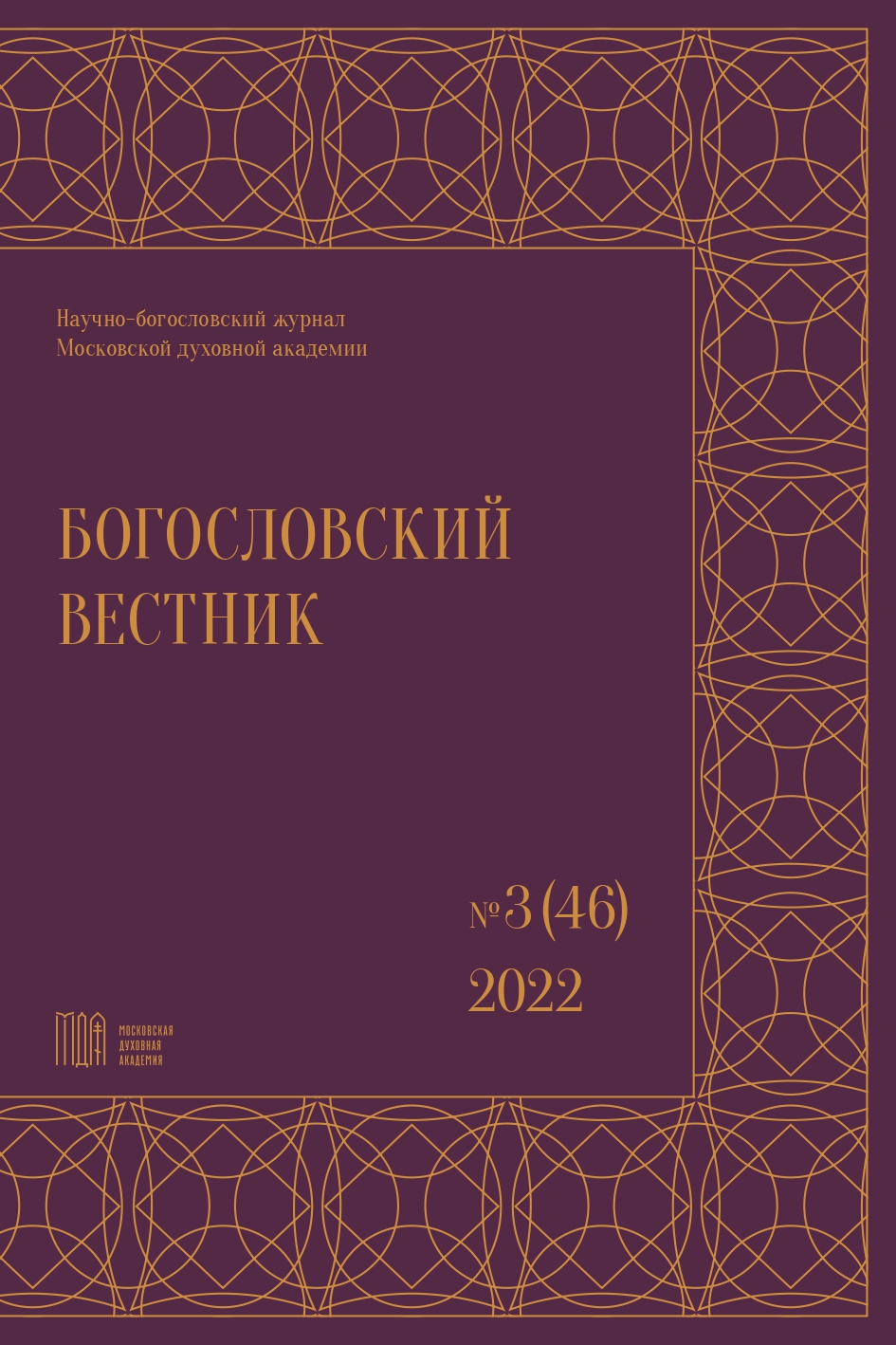The Concept of Anagoge in the Exegetical Works of St. Jerome of Stridon (345–420) and Subsequent Latin Exegetical Tradition
DOI:
https://doi.org/10.31802/GB.2022.46.3.005Keywords:
biblical exegesis, biblical hermeneutics, Latin tradition, st. Hieronymus of Stridon, anagoge, spiritual interpretationAbstract
At present, in Russian scientific and educational literature, the term of Latin exegesis anagoge is usually understood as the eschatological meaning of Holy Scripture. A large number of ancient Latin authors who use the term do indeed demonstrate just such an understanding. This in some cases leads to too broad a generalization and gives the impression that all exegetes use the term in this sense. However, it must be borne in mind that in Latin exegetical literature st. Jerome was the first to use anagoge on the basis of the meaning of ἀναγωγή among Greek interpreters, who often used this word to denote any spiritual interpretation. So, St. Jerome denotes anagoge all kinds of spiritual sense of Scripture. In the subsequent Latin tradition, the semantic field of this term has repeatedly changed, as a rule, towards a narrower specification of meaning. Within the framework of this article, an attempt is made to determine the main meanings of anagoge in Latin exegetical literature, which will contribute to a more correct and clear understanding of both the terminology and the hermeneutic methods of the ancient Latin interpreters.
Downloads
References
Beda. De arte metrica // PL. T. 90. Col. 150–176.
Eucherius Lugdunensis. Opera omnia / ed. C. Wotke. Windoboae: Bibliopola academiae litterarum Caesariae Vindobonae, 1894. (CSEL; vol. 31).
Eucherius Lugdunensis. Instructiones / ed. C. Mandolfo. Turnhout: Brepols, 2004. (CСSL; vol. 66).
Iohannes Cassianus. Conlationes / ed. Petshenig. Vindobonae: Pilium Bibliopolam Academiae, 1886. (CSEL; vol. 13).
Heterius Uxamensis. Epistola // PL. T. 96. Col. 893–961.
Hieronimus Stridonensis (ps.).Commentaria in Iob // PL. T. 26. Col. 619–802.
Hieronimus Stridonensis. Epistolae 71–120 / ed. I. Hilberg. Wien: Österreichische Akademie der Wissenschaften, 1912. (CSEL; vol. LV).
Hieronimus Stridonensis. Epistolae 1–70 / ed. I. Hilberg. Wien: Österreichische Akademie der Wissenschaften, 1910. (CSEL; vol. LIV).
Hieronimus Stridonensis.Commentaria in Isaiam // PL. T. 24. Col. 17–678. Hieronimus Stridonensis.Commentaria in Hieremiam // PL. T. 24. Col. 679–937. Hieronimus Stridonensis.Commentaria in Ezechielem // PL. T. 25. Col. 15–490. Hieronimus Stridonensis.Commentaria in Danielem // PL. T. 25. Col. 491–584. Hieronimus Stridonensis.Commentaria in Amos // PL. T. 25. Col. 989–1096.
Hieronimus Stridonensis.Commentarii in Sophoniam // PL. T. 25. Col. 1337–1388. Honorius Augustodonensis. Expositio in Cantica Canticorum // PL. T. 172. Col. 357–496. Honorius Augustodonensis. De escilio et patria animae // PL. T. 172. Col. 1214–1246.
Hugo de S. Victore. De Scripturis et scriptoribus sacris praenotatiunculae // PL. T. 175. Col. 9–28.
Rabanus Maurus.Commentaria in Exodum // PL. T. 108. Col. 9–246.
Smaragdus S. Michaelis. Collectiones in epistolas et euangelia lectio libri apocalypsis beati Ioannis Apostoli IV // PL. T. 102. Col. 15–522.
Symphosius Amalarius. De ecclesiasticis officiis // PL. T. 105. Col. 985–1242.
Théodoret de Cyr.Commentaire sur Isaïe / éd. J.-N. Guinot. T. III. Paris: Cerf, 1984. (SC; vol. 315).
Бланшар И. М. Определяющие принципы патристической герменевтики в свете последних изменений в библейской экзегезе / пер. П. Б. Михайлов // XXII Ежегодная богословская конференция ПСТГУ: Материалы 2011. Т. 1. М., 2012. С. 390–396.
Добыкин Д. Г. Православное учение о толковании Священного Писания: лекции по библейской герменевтике. Санкт-Петербург: Изд. СПбДА, 2016.
Михайлов П. Б. Экзегетика Священного Писания: Каппадокийские отцы. Москва: Изд. ПСТГУ, 2018.
Протопопова И. А. Философская аллегория, поэтическая метафора, мантика: сходства и различия // Труды Русской антропологической школы. 2004. № 1. С. 61–81.
Соловьев Р. С. Гомер как первый богослов: аллегория и символ в трактате Порфирия «О пещере нимф» // Вестник ПСТГУ. 2020. Вып. 64. С. 47–66.
Тимофеев Б. Ю., прот. Понятие ἀναγωγή в древней греческой экзегетической литературе // Богословский вестник. 2021. № 2 (41). С. 254–279.
Фокин А. Р. Блаженный Иероним Стридонский: библеист, экзегет, теолог. Москва: Центр библейско-патрологических исследований, 2010.
Brown D. Vir trilinguis. A study in the biblical exegesis saint Jerome. Kampen: Kok Pharos, 1992.
Jay Pierre. Ľexégèse de saint Jérôme ďaprès son «Commentaire sur Isaïe». Paris: Études Augustiniennes, 1985.
Simonetti Manlio. Lettera e/o allegoria: Un contribution alla storia dell’esegesi patristica. Roma: Institutum patristicum «Augustinianum», 1985. (Studia ephemeridis «Augustinianum»; t. 23).
Downloads
Published
How to Cite
Issue
Section
Categories
License

This work is licensed under a Creative Commons Attribution-ShareAlike 4.0 International License.








